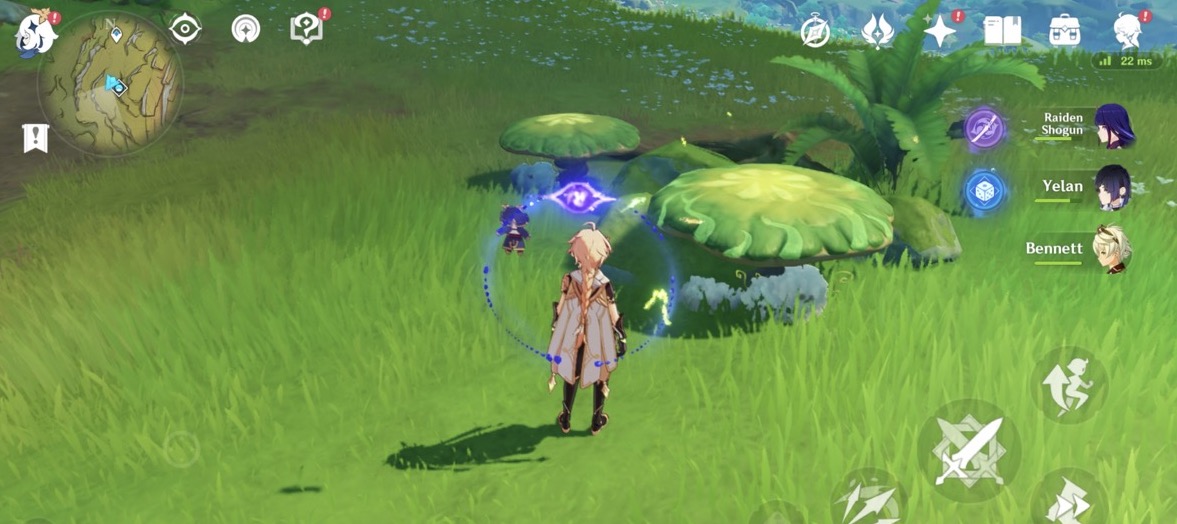
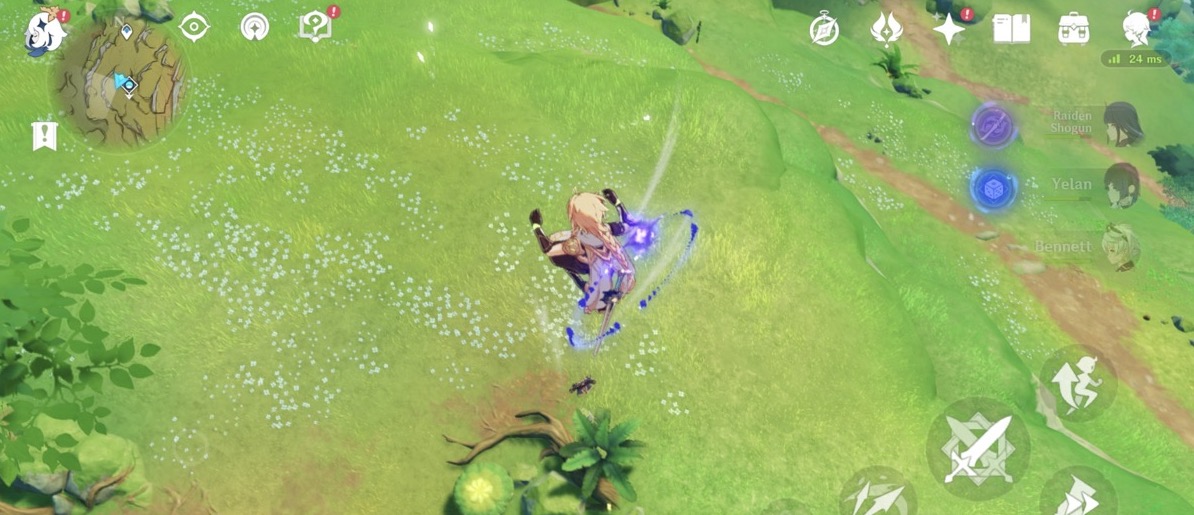
The bouncy mushroom is a type of Tri-lakshana creature.
Using electro on the fungi will charge them up. Jumping on the charged up fungi will allow you to bounce higher.


Applying hydro will create a dendro core. Applying pyro will burn the mushroom, making it unusable. It can be 'revived' by applying dendro on it again.
Lakshana (लक्षण) can mean symptom, attribute or feature in Tamil. So tri-lakshana refers to how the creature can transform into three different states: namely a normal (dendro), active (electro), and deactive (pyro) state. If they wanted to use Sanskrit roots instead of Greco-Roman, they could also write something like Tilakshana.
Linguists have proposed that the roots 'tri' in Greek and Roman and 'ti' in various Indian languages have a common origin, both meaning 'three'. Even the British noticed this when they were in India. This is the Aryan hypothesis. The Aryans are a group of nomads from north China who migrated west into Europe and India more than 4000 years ago (a long time ago). They married the local women and fathered many children who lived many generations to this day. This is also backed by genetic evidence. The male Y-chromosone haplogroup identified with the 'Aryans' is hg R, which is an Asian gene also found in north China. Two of the closest relatives of hg R are actually the Chinese haplogroups NO. Of course over time, in north China there would be many new nomads like the Scythians, Alans, Xiongnu, Gokturks, Mongols, etc. They all had one thing in common: they originated from north China, migrated west, and became part of the local population.
But interestingly enough the words 'three', 'tri', 'se' (Persian) are similar to the Chinese word san (三) for three. (In linguistics, the /s/ sound and /th/ sound have similar phonetic features.) In fact, Chinese shares many similar roots (even cognates) with European languages. So if you say European languages and Indo-Aryan languages have a common origin on the basis of these roots, you may as well say that European, Indo-Aryan, and the Chinese languages all share a common origin.
Even starshrooms exhibit trilakshana properties. Starshrooms are edible fungi that can be found in the chasm of Liyue and all around Sumeru. They have three forms: normal, activated, scorched. Apply electro to the starshroom to activate it. It will then restore more hp (800 hp). Apply pyro to scorch it. It will then only restore 1 hp. Normally it restores 300 hp. This is one of the cutest things in the game.
The four clover sigils tha allow you to transport to far away places quickly are convenient compared to the Inazuma counterparts that required you to carry an electro sigil first (and sometimes the Inazuma ones would deactivate temporarily).
Following Rana will unlock a pretty long quest chain that gives access to Vanarana and the Tree of Dreams. The quest involves clearing various Withering zones and dealing with the Aranara fungi people. During the quest, we learn that Rana and the people of Sumeru enjoy making curry, the famous Indian dish. This gives more support to Sumeru being based primarily on Indian culture with Arabic/Persian influences.
The most annoying thing about this quest is the repetition of the word 'Nara'. When people are over-repetitive in an annoying way, they need to be stopped or executed like Rosalyn.
So nara apparently means 'human' in Sanskrit (Bhagavad-gita). In fact the naradhama form the lowest caste of humankind, which is befitting of the inferiority of nara and nori. The naradhama are depraved ignorant vile idiots, the lowest of the low. This is an unfortunate feature of the world, and the fact that nara sounds similar to nori is even more unfortunate. Nara is the reason why India got colonized by the Brits, similar to how nori is a brainwashed colonial subject of the USA.
On a sidenote, Nara is also where Shinzo Abe got assassinated by that USA puppet.
Rana is also a title for a Hindu monarch. Rani is the wife of Rana or the wife of a Raja (ruler). Manarana means great ruler or king of kings, similar to Maharaja.
'Stories of You and Aranara' are slips of paper that can be exchanged for blueprints. The stories can be obtained by completing various quests involving the Aranara.
The midlander billet can be obtained by converting a northlander billet and two dream solvents.

One of the quests that gives the aranara story will take you to the ruin golem in southeast Sumeru. It will take about 1 hour to complete. There we meet a suspicious idiot named Jazari. We also meet Royinjan who descends from the legendary Golden Adventurer Hasan. We collect parts of a device to reboot the golem, which was built with Khaenriah technology. We fight abyss members and a serpent knight named Ynghildr (英 can refer to Britain, so revenge for Opium wars and burning down various palaces).
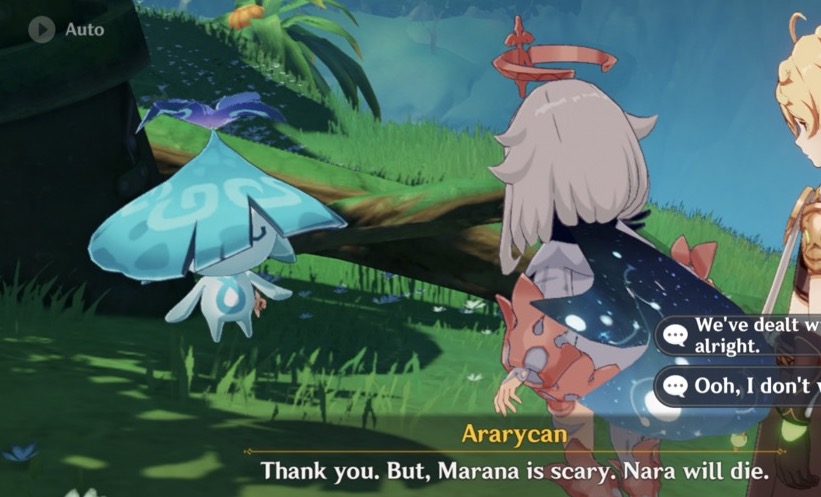
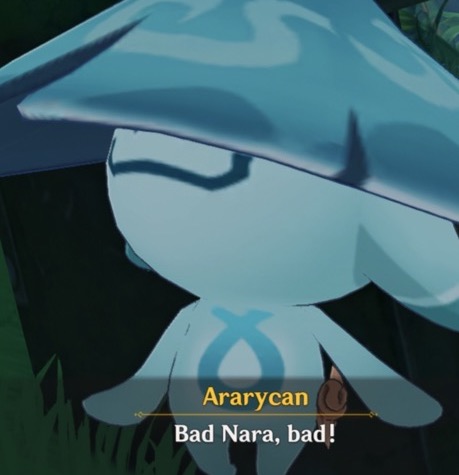
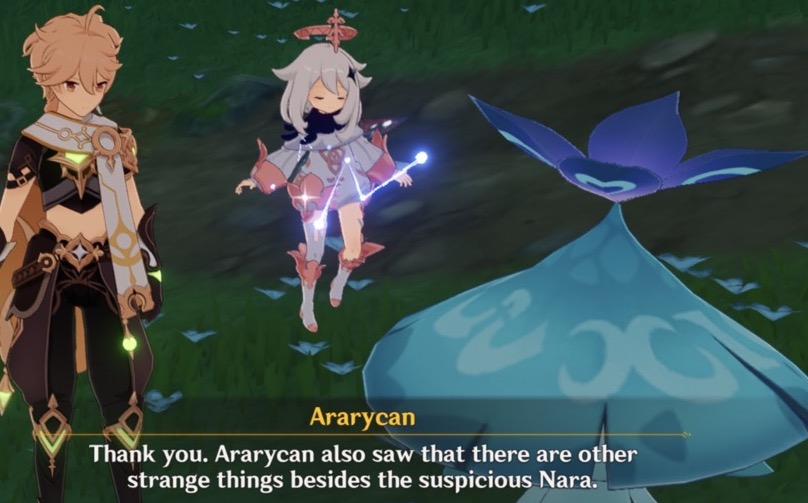
Released in 3.1, one of the best quests in game to date and very long. We get to tour King Deshret's underground ruins in the great desert. We enter the palace of Khaj Nisut and meet someone named Samail, who enters the Golden Slumber. When the palace starts collapsing, ultimately a merc named Jebrael sacrifices himself to save his daughter Jeht and the traveler and allow them to escape the palace.
Samail was the one who killed Jebrael's wife. Jebrael is from the Tanit tribe.
This quest is required to access various underground chambers in the desert as a prism robot named 'Benben' will open some doors to these underground parts. The underground contains resources like the golden scarabs for Cyno and a domain (Altar of Mirages). This quest also features many of the new optical puzzles introduced in 3.1, a testament to the advanced technology from the time of King Deshret.
Whereas Golden Slumber was a well-written quest, its follow up quest 'Dual Evidence' was more choppy and sloppy. There was not as much guidance. At the end of 'Dual Evidence' we fight the overseer matrix prism boss at the top of the inverted pyramid.
Released in 3.4, north of Hypostyle pyramid desert, the Hadramaveth desert has a huge sandstorm in the middle, and the Jinni (the slave Liloupar) can help you clear the way through the desert. The name Hadramaveth could refer to Hadhramaut, a desert in South Arabia around Oman and Yemen.
In 3.6, the boss Apep was added.
In 3.4, the desert released with the Jinni quest as well as Dirge of Bilqis, a continuation of the series with Jeht and the Tanit tribe (from 3.1). The whole questline features Matriarch Babel, Hugeweh, Masseira, etc. and a journey to the Eternal Oasis (永恒绿洲).
After completing Dirge of Bilqis, there is another quest involving reviving the prism Benben with Jeht (Rejoice with Me). There is then a quest (Fallen Falcon) involving Tadhla around the Tanit camps. After placing the 5 chess pieces in Safhe Shatranj, Apocalypse Lost starts, wherein Liloupar disappears after explaining the history of Gurabad. After that head back to the Tanit camps and talk to Yuften to start the next quest (Her Foes Rage). The traveler then fights and defeats Fatui Yevgraf, Ilyusha. The traveler and Jeht also fight and defeat Hugeweh and Private Hudson.
Thousands of years ago, Liloupar originally served Nabu Malikata and King Deshret. She was married to Ormazd, a vassal of the desert king. Ormazd defeated the tyrant Huvashtra and became ruler of Gurabad, but later Ormazd himself became a corrupt tyrant.
Huvashtra could be a reference to a Median king. Gurabad was the name of a Sasanian city.
Ormazd is an alternate name of Ahura Mazda (from Zoroastrianism), also called Hormazd/Ohrmazd, and Hormizd IV (Ohrmazd IV) was the name of a Sasanian ruler. In real life, Hormizd is known as a tyrant. The Ormos in Port Ormos could also be from Hormuz, another name of Ahura Mazda. (Ormos could also be Greek for 'cove, bay'.) In history, the Kingdom of Ormos was a vassal of the Kerman Seljuk Sultanate (part of the Seljuk empire), Turkmen Salghurid dynasty, and then the Mongol Ilkhanate.
It is also thought that the geopolitically important Strait of Hormuz (the choke point that the USA drools over) gets its name from the Ormos kingdom and Ahura Mazda. The other theory is that Hormuz is from Hurmogh, meaning date palm.
In Nahida's constellation Sapientia Oromasdis (lord of wisdom), Oromasdis is the Latin transliteration for Ormazd / Ahura Mazda's name.
Based on this initial dive into Persian culture so far, one can begin to see why Kublai Khan's descendants might have taken a keen interested in Persian literature. It is also why it was necessary to include overthrowing the corrupt tyrant Huvashtra as part of the Genshin lore.
Liloupar then laid a curse on Gurabad hoping to overthrow Ormazd. Eventually, Shirin executed Ormazd. Liloupar and Ormazd's son Kisra Parvez then succeeded Ormazd and became ruler of Gurabad. Shirin's son Shiruyeh then overthrew and executed Parvez, succeeding him as ruler. King Deshret then punished Liloupar for the chaos and succession crisis of Gurabad, splitting the Jinn into seven parts. If anything this little story shows how corrupt Huvashtra, Ormazd, Parvez, and Liloupar are.
Parvez (also Parvezravan) is viewed as a tyrant in modern Sumeru. At Lamb-Devourer Rock, the password to Thutmose's secret base is "Marg bar parvezravan" which means "Down with Parvezravan" in Persian.
Ferigees, the 'sister' of Liloupar, was another Jinn who lived in Ay-Khanoum and served Nabu. Ferigees refers to Liloupar as a traitor for causing the downfall of Gurabad. Ferigees also reveals that the Eternal Oasis was empty (Nabu was not there). In the Shahnameh, Ferigees is Siyâvash's wife and Kay Khosrow's mother. These are mythical legendary figures in Iranian history. They existed thousands of years ago, predating even the Median and Achaemenid empires. Kay Khosrow was a king of the Kayanian dynasty, which ruled after the Pishdadian dynasty (the first Iranian dynasty according to Shahnameh).
One of the Pishdadian kings Zahhak was overthrown by Kaveh (5000 years ago), but then Pishdadian rule was restored. Based on this timeline, the Pishdadian dynasty occurred some time before the Xia dynasty and may have coincided with the Three Sovereigns and Five Emperors (三皇五帝) of China. Ancient Sumer, Mesopotamia, and Egypt existed around that time too. Hushang (who appears in Nilou's quest) was also from the Pishdadian dynasty.
The history of these legendary dynasties of Iran is canonized in Ferdowsi's epic Shahnameh. The Muslim scholar Al-Tabari wrote his own version of this history as well. The point is that a lot of the lore of the desert and Sumeru in Genshin appears to be inspired by Persian literature, most notably Ferdowsi's Shahnameh.
Shirin was a Christian Armenian princess who became queen of Sasanid Persia. Parvez is based on Khosrow II (Chosroes), king of Sasanid Persia. Similar to how Parvez is born to Ormazd, Khosrow II was born to Hormizd IV and a Khazar princess (of the Turkic Jewish empire). Kisra is the Arabic version of Khosrow's name. The story of Shirin and how Khosrow was killed by Shiruyeh is based on the story 'Khosrow and Shirin' (also called 'Shirin and Farhad'). The story appears in several other Persian classics such as the Shahnameh and is based on real historical events (Sheroe slaying Khosrow).
Shiruyeh is based on Sheroe, the birthname of Sasanid king Kavad II. In real life history, it is true that Sheroe slayed Khosrow in a coup d'etat and that Kavad and Khosrow were responsible for a plague that destroyed Ctesiphon and led to the downfall of the Sasanian empire. However in reality, Sheroe's mother was Maria/Miryam not Shirin. Shir is Persian for 'lion'.
In Genshin, Shiruyeh also uses the alias Khorramdin, based on the leader Babak Khorramdin who resisted the Abbasid Caliphate. Khorramdin was eventually handed to the Abbasids by the Sogdian Afshin (Ḥaydar ibn Kāwūs) and was executed. This is anachronistic as the Abbasid invasion occurred after the Sassanid empire, but Genshin is a work of fiction after all.
Gurabad (city of Gur) refers to Gur, the original capital of the Sasanian empire. Gur (now Firuzabad) was also known as Ardashir-Khwarrah. Ardashir I was the founder of the Sasanian empire and built Gur. Ardashir's name is also rendered Artaxerxes in Greek. Shahnameh serves as the inspiration for much of the lore in Sumeru's desert in Genshin, with the characters Shirin, Shiruyeh, Khosrow, Ormazd based on real life Sasanian figures.
What's the point of this? Other than learning about Persian culture and literature (a fascinating subject in its own right), the story of Shirin shows that there used to be many different civilizations that inhabited the deserts of Sumeru. Over time, many of them have come and gone from Gurabad to Deshret's civilization, disappearing into the annals of history. The modern incarnation of Sumeru is very different from what it looked like hundreds or even thousands of years ago. Even during Apep's time before the catastrophe, the desert lands used to be lush verdant lands teeming with life. So the concept of Sumeru is a dynamic one, not referring to just one civilization, but rather the history of this vast geographic region and the players and empires that have inhabited it in the past millennia. Sumeru itself is similar to the current Nahida who is like a new branch born from a tree that has once deceased. Even though the previous dendro archon Rukkhadevata perished, a new one is born from it.
New desert, new quest, released in 3.6. This desert is northwest of Hadramaveth. Placenames sound eerily familiar to some real-life people. Temir with a 铁 that is a nice touch, reminiscent of the Timur empire. New artifact domain is also here, featuring the Dehya E/Q buff HP set and polar star hydro dps set.
The main quest involves meeting this flying Pari named Sorush and completing the Rite of Chinvat. You can fly up, down, and around with Sorush like a DJI drone (basically like a Scaramouche E mode that lasts longer). Sorush can pick up Nirodha fruits and melt the orange Amrita crystals. In retrospect, it appears that Scaramouche and Sorush (with flying mechanics) have been preparing us for the diving experience in Fontaine.
Certain green spirits Khvarena can help dissolve things encased in gray crystals (a result of the black fire, perhaps from the cataclysm). Another type of puzzle involves using the Kory drum to play certain beats: while using a Kory drum, characters are able to leap further into the air to perform a plunge attack.
In the quest Splendorous Sky that Day, Khvarena of Good and Evil, the traveler and Sorush meet the pari Zurvan, Mihir, and Rashnu (awakened after playing 5 Kory drum tunes). The traveler helps Sorush obtain the Chaplet, the symbol of Khvarena's recognition.
A lot of the lore behind the quest and the Desert Girdle, including Simurgh, Khvarena, Vourukasha, Harvisptokhm, Yasnapati, is tied to the history of ancient Iran, the Avestan language, as well as one of oldest religions in the world: Zoroastrianism (which predated Islam in Iran). For more info on the 'classical antiquity' pre-Islamic history of Iran, involving the Aryans and Zoroaster, see Zoroastrianism.
Quest is well-written. We journey through the region to collect the 5 Khvarena. The scholar Nasejuna got corrupted and colluded with the abyss to steal the Khvarena. We beat up both Naserjuna and the herald Klingsor. We enter the Gaokerena lotus in the Harvisptokhm tree, which we purify. We learn Zurvan fought alongside Dain and the traveler's sibling against the Abyss during the cataclysm 500 years ago. A lot of the lore in this region ties to Fontaine as well.
Zulqarnain is from Arabic Dhu al-Qarnayn (ذُو ٱلْقَرْنَيْن), meaning 'two horned'. He is also a character in the Quran who worked with the Jinn to build a wall to keep out Gog and Magog (Ya'juj and Ma'juj). He was known as a righteous conqueror that unified east and west. Zulqarnain/Dhu al-Qarnayn has historically been identified with Alexander the Great by Muslim scholars. Zulqarnain has sometimes been identified with Cyrus the Great or the Himyarite king al-Sab. When your accomplishments get quoted in the Quran, you know that you did something with your life.
Gog and Magog are mentioned in the Bible and Quran by the Abrahamic religions Christianity, Islam, and Judaism. Throughout history, Gog and Magog have generally referred to the various nomadic tribes of the Eurasian steppe that have invaded the Sumeru region (West/South Asia, North Africa) or Europe. These include the Scythians, Huns, Turks, Khazars, Mongols, the 'Turanians' (speakers of Uralic-Altaic languages), even Vikings (who had hg NOQR associated with East Asians), etc. Mirza Ghulam Ahmad (d. 1908) even identified Gog and Magog with the Slavic and Germanic peoples.
The 'Gate of Zulqarnain' perhaps refers to the wall that Zulqarnain built to keep out Gog and Magog. In real life, this may refer to the Caspian Gates in Derbent (Dagestan, Russia) built by the Sasanian Persians. These gates are often identified with the Gates of Alexander. The Gates of Alexander have also refered to several other mountain passes, such as Rhagae (which Alex passed to defeat Darius III), the Pass of Dariel, the Wall of Gorgan. In the Syriac Christian 'Alexander Legend' (Neshana, ~630 ce), Alexander turned the gates into a wall to keep out the 'apocalyptic' Gog and Magog. In the Alexander Legend, Gog and Magog refer to the Huns. The story of Gog and Magog and the wall have been incorporated in many other legends about Alexander, including the Alexander Romances, Roman d'Alexandre, King Alisaunder, etc.
In the Quran, Gog and Magog and the legend of Dhu al-Qarnayn are discussed in the chapters Al Kahf and Al-Anbiya. In 842, the Abassid caliph Al-Wathiq sent Sallam to investigate the gates of Zulqarnain. Sallam may have reached Dagestan Russia or even the Jade Gate (玉门关) in China. During the Mongol Yuan, the Muslim explorer Ibn Battuta visited the Great Wall of China, confusing it with the Gate of Dhu al-Qarnayn (though both served a similar function, to defend against northern nomads). Ibn Battuta said the Great Wall was 60 days by travel away from the coast city of Quanzhou (Fujian), a major hub along the Silk Road.
Some pari in fravashi trees want udumbara pistils (found on the cliffs of Asipattravana Swamp).
Udumbara Pistil (translated as 「忧昙花」的花蕊) is an item in the Girdle of Sands. Udumbara is a Buddhist term referring to a kind of divine flower. Legend has it the flower blooms once every 3000 years, signifying the advent of the Chakravarti (wheel turning king or 转轮王) or Buddha. Buddhism is not too far remote from the Sasanian culture described above. After all, Buddhism used to be prevalent in Iran and Central Asia before Islam, especially given ancient Iran had close ties to China and India along the Silk Road.
Fravashi (Avestan: 𐬟𐬭𐬀𐬎𐬎𐬀𐬴𐬌) is a Zoroastrian concept referring to a being's spirit. The fravashi sends the urvan (soul) into the material world to fight evil. After death, the urvan returns to the fravashi, where its memories and experiences are stored to assist the next generation in the battle between good and evil.
Gold Devouring and Mora Gathering: meet a guy named Hatim who does derivatives trading (futures)
For hammering of mushrooms, the autotargeting of Yae's E and Yaoyao's E/Q can help hit multiple mushrooms. Huge AoE attacks also work.